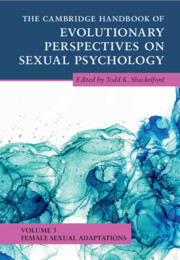Book contents
- The Cambridge Handbook of Evolutionary Perspectives on Sexual Psychology
- The Cambridge Handbook of Evolutionary Perspectives on Sexual Psychology
- Copyright page
- Contents
- Contributors
- Preface
- Part I Precopulatory Adaptations
- Part II Copulatory Adaptations
- 8 Sexual Fantasies
- 9 Copulatory Thrusting
- 10 Female Provision of Oral Sex
- 11 The Adaptive Value of Women’s Orgasm
- 12 Copulatory Urgency: An Evolutionary Perspective of Women’s Sexual Desire
- Part III Postcopulatory Adaptations
- Index
- References
8 - Sexual Fantasies
from Part II - Copulatory Adaptations
Published online by Cambridge University Press: 30 June 2022
- The Cambridge Handbook of Evolutionary Perspectives on Sexual Psychology
- The Cambridge Handbook of Evolutionary Perspectives on Sexual Psychology
- Copyright page
- Contents
- Contributors
- Preface
- Part I Precopulatory Adaptations
- Part II Copulatory Adaptations
- 8 Sexual Fantasies
- 9 Copulatory Thrusting
- 10 Female Provision of Oral Sex
- 11 The Adaptive Value of Women’s Orgasm
- 12 Copulatory Urgency: An Evolutionary Perspective of Women’s Sexual Desire
- Part III Postcopulatory Adaptations
- Index
- References
Summary
Sexual fantasies refer to mental imagery of sexual activity with an emotional component that absorbs the fantasizer. These images are often sexually arousing and enjoyable, but they can elicit guilt and be unwanted and intrusive. Reported frequency of sexual fantasizing is subject to large individual differences. The present chapter reviews and discusses the role of motivational tendencies underlying sexual fantasies and the relationship between sexual functioning and sexual fantasies. Men report more frequent fantasies than women, but at least part of the difference is explained by greater frequency of masturbation accompanied by fantasies for men than women. Sexual desire does not require the experience of fantasies, but fantasy frequency is robustly related to sexual desire in the reproductive years. Tendency to experience sexual fantasies is related to imagery ability, in general, but the modest correlations suggest independent processes. Unlike sexual activity that requires compromise between partners’ desires, fantasies are unconstrained by physical and social reality; as such, they provide a window into sexual motivations that guide cognitions and behavior. Predictions of sex differences in fantasy contents based on evolutionary theory have been confirmed by many studies. Women are more likely than men to fantasize about sex with the current partner, and less likely than men to fantasize about group sex, sex with strangers, extradyadic relationships, and sex with (legally) much younger partners. This is interpreted as fantasies reflecting sex-differentiated mating strategies. However, a substantial proportion of women report fantasies of group sex, sex with unknown men, and sex with men other than their current partner. This suggests that a certain degree of sperm competition has occurred in human evolutionary history, which is corroborated by the relative size of men’s testes in comparison with other primates. Generally (and against expectations), women do not fantasize more about sex with much older partners and famous people. Fantasies involving sexual aggression are very common. Men fantasize more than women about forcing someone to have sex. Some studies report that women fantasize more about being forced to have sex, but others have failed to find this sex differences. Still, more women than men report that the fantasy of being forced to have sex is among their favorites. These fantasies are typically very sexually arousing, but they may challenge evolutionary explanations and the notion of fantasies revealing motivations, as rape is reported to be traumatic and revolting by victims. Several explanations are discussed. Rape fantasies might facilitate intercourse and sexual pleasure in circumstances of psychological ambivalence, when the environment is safe. In women, evidence of a relationship between sexual fantasies and sexual satisfaction is mixed. Sexual satisfaction is unrelated to female coital fantasies and to male fantasies, in general. Many variables that may cause fantasy-related dissatisfaction are discussed; these include fantasies provoking guilt feelings, preference for arousal solely induced by sensory and emotional stimulation, fantasies being used as escapes from relationship problems and other stressors of reality, and lack of adequate sleep leading to greater fantasy-induced arousal.
- Type
- Chapter
- Information
- Publisher: Cambridge University PressPrint publication year: 2022
References
- 3
- Cited by



